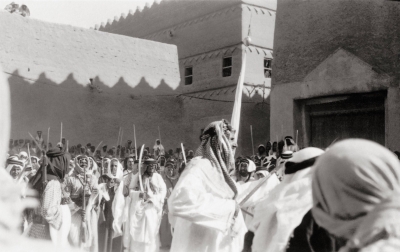
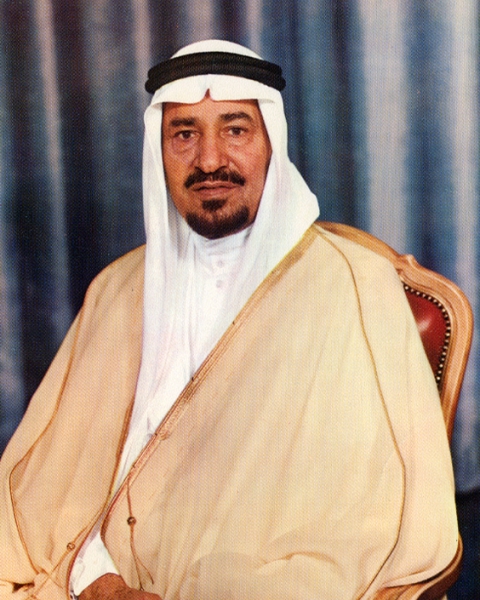
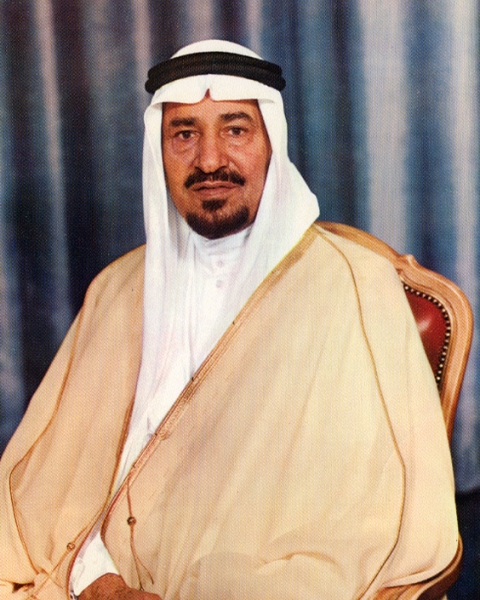

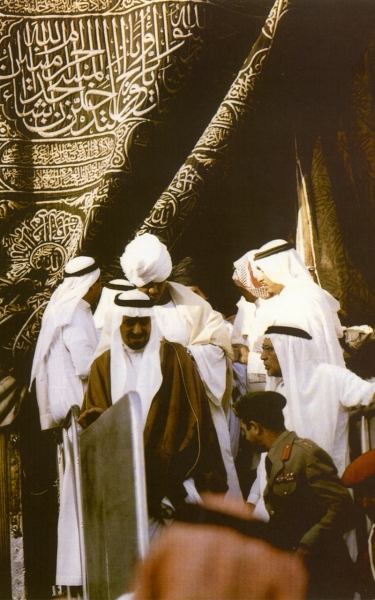
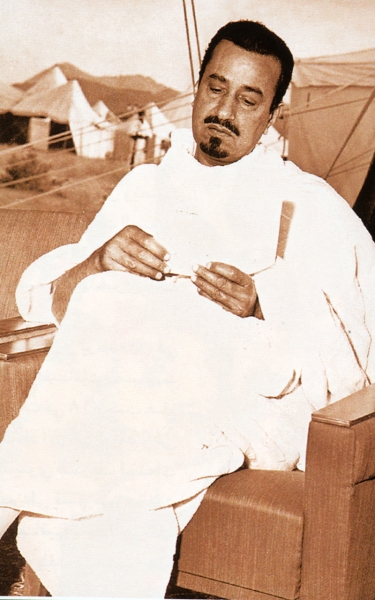
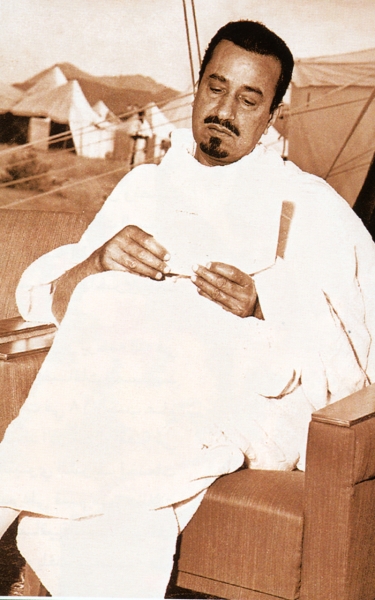
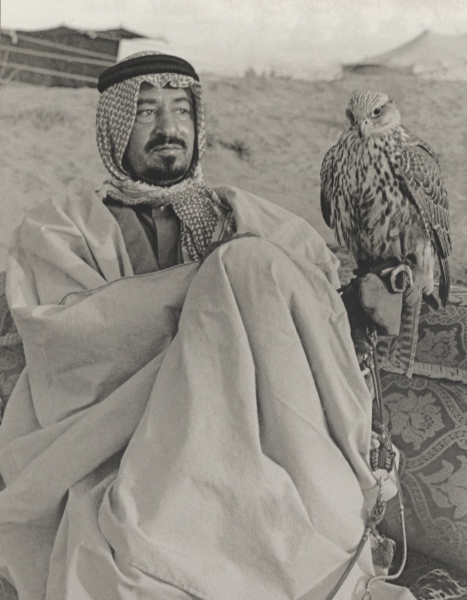
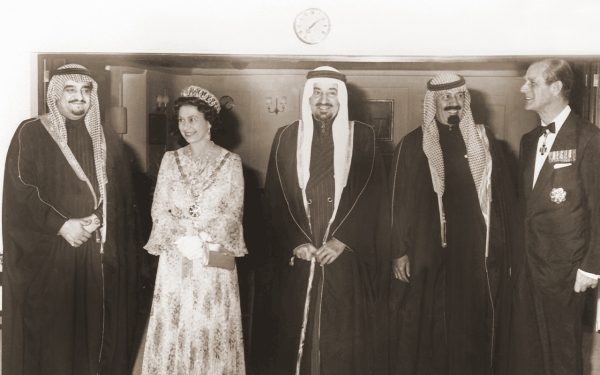
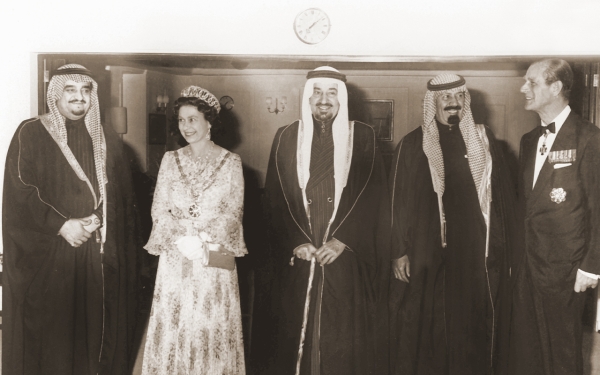
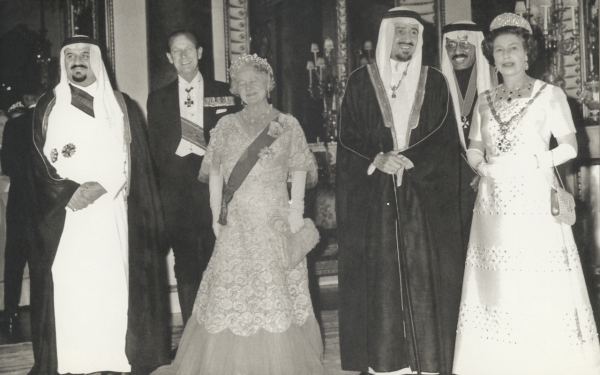

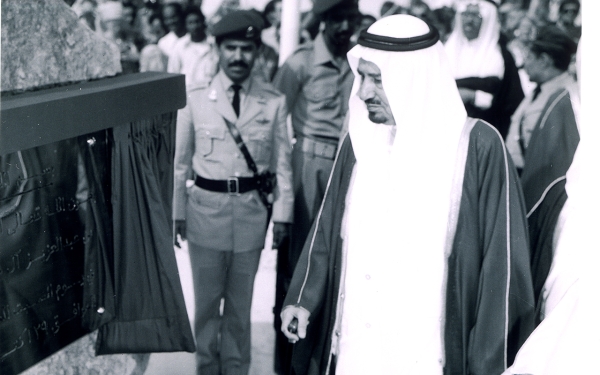

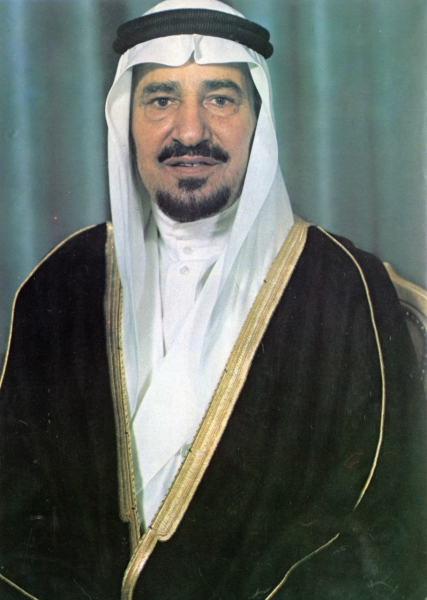
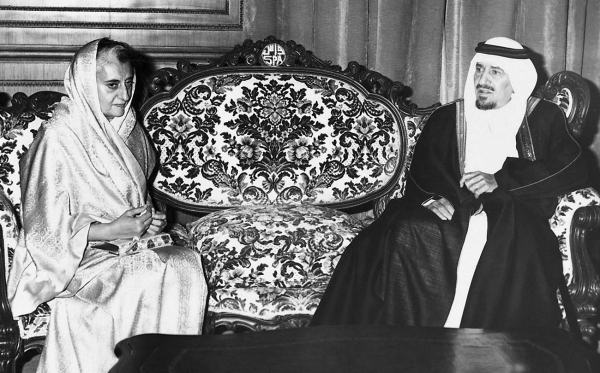
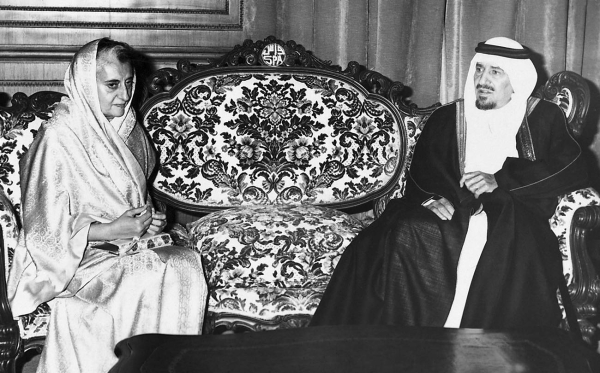
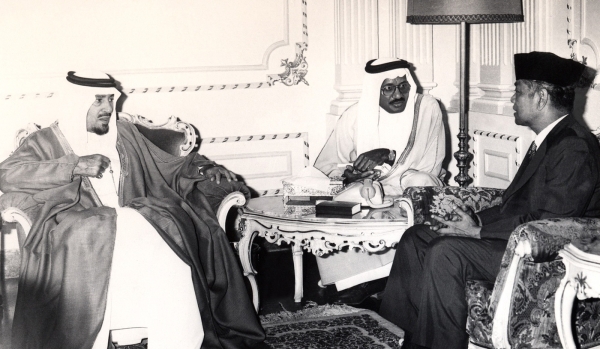
King Khalid Bin Abdulaziz Al Saud (1913-1982) was the fifth son of the Founding King and the fourth king of the Kingdom of Saudi Arabia. His reign lasted for seven years, and he was succeeded by King Fahd Bin Abdulaziz. His figure earned admiration and appreciation locally and internationally. He was awarded numerous awards and honors from countries and international organizations, including the King Faisal Prize for Service to Islam.
King Khalid Bin Abdulaziz
He is Khalid Bin Abdulaziz Bin Abdulrahman Bin Faisal Bin Turki Bin Abdullah Bin Mohammed Bin Saud Bin Mohammed Bin Muqrin Bin Markhan Bin Ibrahim Bin Musa Bin Rabi'ah Bin Mani' al-Muraydi from Banu Hanifah, from Bakr Bin Wail, from Rabi'ah Bin Nizar, from Ma'ad Bin Adnan.
His mother was Princess al-Jawhara Bint Musaed Bin Jiluwi Bin Turki Bin Abdullah Bin Mohammed Bin Saud. King Abdulaziz married her in 1908 when she was seventeen years old, and she became his fourth wife. He housed her in al-Hukm Palace in Riyadh. She passed away during the influenza pandemic (Spanish flu) in 1919. Princess al-Jawhara gave birth to King Abdulaziz, Mohammed, Khalid, and al-Anoud.
Birth and upbringing of King Khalid
King Khalid was born in February 1913 while his father, King Abdulaziz, was heading to al-Ahsa to unify it as part of the campaigns to unite the Saudi state. His birth coincided with the recapture of al-Ahsa. He was the fifth son of King Abdulaziz, raised under the care of his father during the unification of various regions into the emerging state. He witnessed his father's victories and the establishment of the modern state system. He grew up in al-Hukm Palace in Riyadh alongside his brother Prince Mohammed Bin Abdulaziz. He memorized the Holy Quran in his childhood and received religious education from prominent scholars.
Education and culture of King Khalid
In his childhood, King Khalid joined his siblings in schools in Riyadh where he memorized the Quran, received religious lessons, learned reading and writing, and memorized the Holy Quran. He was assigned a teacher and mentor within the palace responsible for his good upbringing. King Khalid studied Islamic sciences, particularly under the guidance of prominent scholars, in addition to other subjects at the Mufarrig School within the palace. Among his teachers were Mohammed Bin Marhoom, known as al-Musayyibih, and Sheikh Nasser Bin Hamdan. This school preceded the establishment of the Princes' School and only closed its doors after the opening of formal schools in Riyadh. The Directorate of Knowledge and the beginning of organized education started on March 15, 1926, when King Abdulaziz issued an order to create a special administration to supervise and organize education throughout the various regions of the country, focusing on the teaching and upbringing of the youth.
The Princes' School represented a special educational experience in the history of educating the sons of kings, given its direct connection, both in terms of location and time, to the king. Established in 1935 by King Abdulaziz in his palace, the school aimed to educate the young princes, mainly his sons, grandchildren, nephews, and their descendants from the House of Saud. He named it the Princes' School.
King Khalid's character
King Khalid had noble morals and virtuous qualities. He was modest, humble, and pious. He advocated for goodness and peace, and had serene disposition. He was held dear by his family.
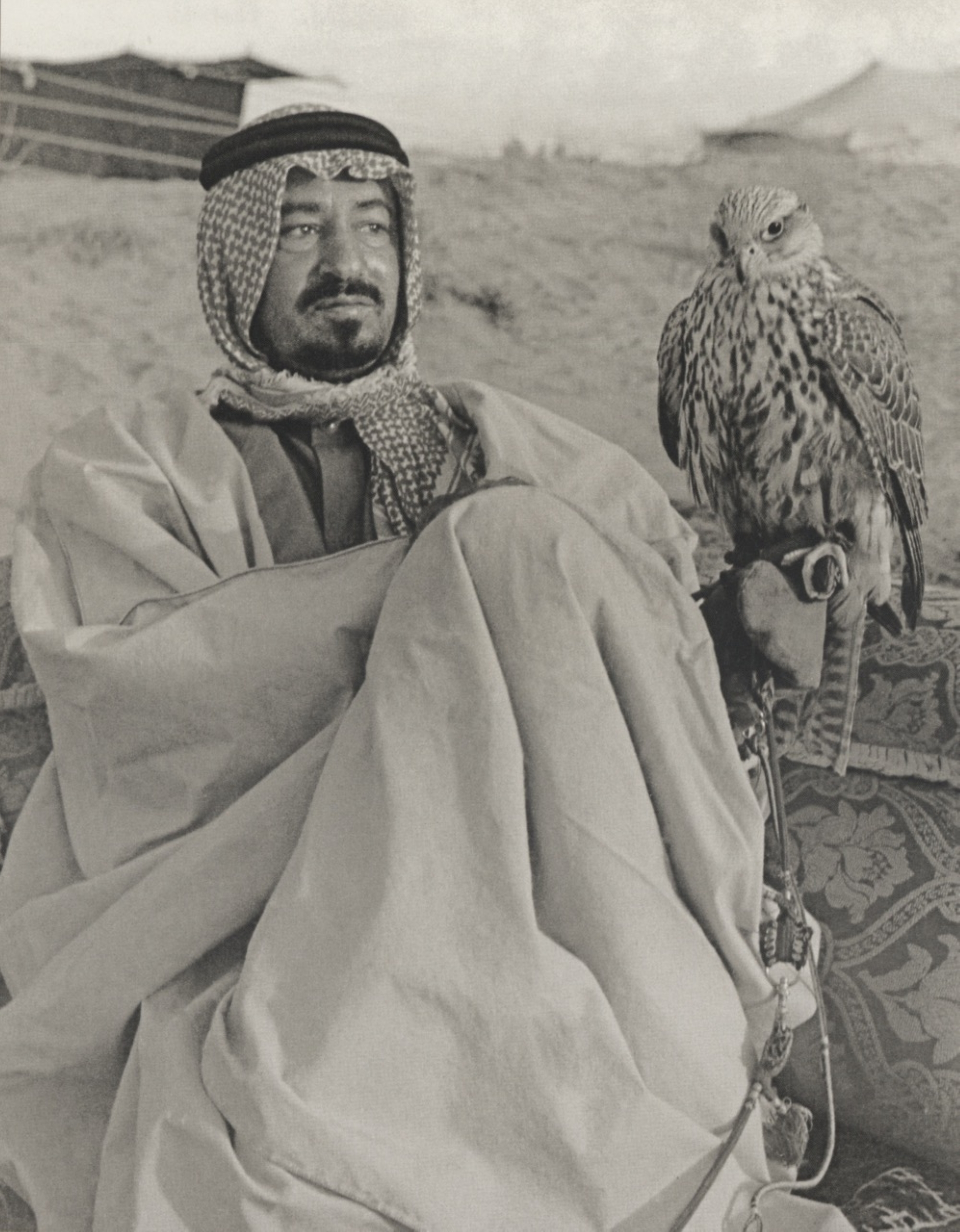
Hobbies and interests of King Khalid
As King Khalid grew up and reached maturity, he trained in equestrianism and shooting, both considered traits of the Arab knight. He excelled in these activities and had a passion for hunting, particularly the hunting trips known in the local culture as falconry trips. He maintained a collection of memorabilia gathered during various hunting expeditions to different locations. His love for hunting and these trips continued even after he assumed the rule. When he left his palace in Riyadh, he preferred spending time in the desert. He organized many large hunting expeditions. King Khalid had a passion for collecting books, often printing them at his own expense. These printed works included legal texts related to jurisprudential rulings, doctrine, Sunnah, and language. His library also housed numerous books that were either written by him or given to him as gifts.
King Khalid's activities before assuming the rule
During his father's era
King Khalid, then Prince Khalid, actively engaged in shooting during his father's journey to Hejaz. The Founding King, accompanied by his brothers, Princes Mohammed and Abdullah, and his sons Mohammed and Khalid, along with several prominent figures and scholars from Najd, as well as individuals who joined them from various Arab regions in 1924. At that time, Prince Khalid was twelve years old. He also experienced another event with his father when King Abdulaziz faced the Ikhwan Revolt in the Battle of Sabilla near al-Zulfi Governorate. He succeeded in defeating them. The Battle of al-Dubdiba took place in the presence of Prince Khalid alongside his father. The battle is named after the location of al-Dubdiba near Kuwait. Faisal al-Duwish fled to Kuwait but was captured and returned to King Abdulaziz, who ordered his imprisonment, bringing an end to the uprising.
King Abdulaziz selected Prince Khalid to lead the Saudi delegation in the Taif Treaty, held to reconcile King Abdulaziz and Imam Yahya Hamid al-Din. The selection of Prince Khalid was a recognition of his wisdom and inclination towards peaceful solutions. The treaty was negotiated in Taif between the Saudi delegation led by Prince Khalid and the Yemeni delegation led by Abdullah Bin al-Wazir. The negotiations concluded with the signing of the treaty on May 19, 1934.
After the annexation of the Hejaz to Saudi rule, King Abdulaziz appointed his son Faisal as his deputy in the Hejaz. Prince Khalid was appointed deputy to his brother Faisal. Prince Khalid demonstrated his competence in his assigned role during this period, performing his duties excellently and serving as an assistant to his brother throughout that time. He also assumed the leadership of the Emirate of Makkah al-Mukarramah and the Ministry of Interior on behalf of Faisal for a certain period when Prince Mohammed Bin Abdulaziz, the deputy president of the council of agents, was ill. This coincided with Prince Faisal's official mission outside Saudi Arabia on April 12, 1932. King Abdulaziz entrusted Prince Khalid with the presidency of the council of agents, the Emirate of Makkah al-Mukarramah Province, and the Ministry of Interior until the return of Prince Faisal, who remained outside Makkah for about five months.
During the war with Yemen, King Faisal led the armies heading there. King Abdulaziz issued an order for Prince Khalid to oversee the affairs of the presidency of the council of agents, the Emirate of Makkah al-Mukarramah Province, and the Ministry of Interior on behalf of his brother Prince Faisal during his absence from the region. When the Directorate of Foreign Affairs transformed into the Ministry of Foreign Affairs and its tasks were assigned to King Faisal in 1930, Prince Khalid, as his right-hand man, shared some of these responsibilities, allowing Prince Faisal to focus on foreign affairs. Prince Khalid even traveled with him on many diplomatic visits outside Saudi Arabia. Together, they visited five Arab and friendly countries, including Egypt in 1939 and London in 1939 to attend the conference on Palestine, where they were honored and celebrated. They also visited Paris the same year and later traveled to Alexandria and Bahrain. Additionally, they visited the United States four years later, receiving diplomatic honors and celebrations from the Arab and Saudi communities. They were also celebrated upon their return to Makkah al-Mukarramah in Jarwal Neighborhood.
Crown prince designation
After assuming the reins of power in Saudi Arabia, King Faisal chose his brother Khalid as the crown prince on Monday, March 29, 1965. During his tenure as crown prince, Prince Khalid served as the Deputy Prime Minister and continued in this role for about ten years. Throughout this period, he was King Faisal's right-hand man, exercising his duties under King Faisal's supervision, benefiting from his political experience and wisdom.
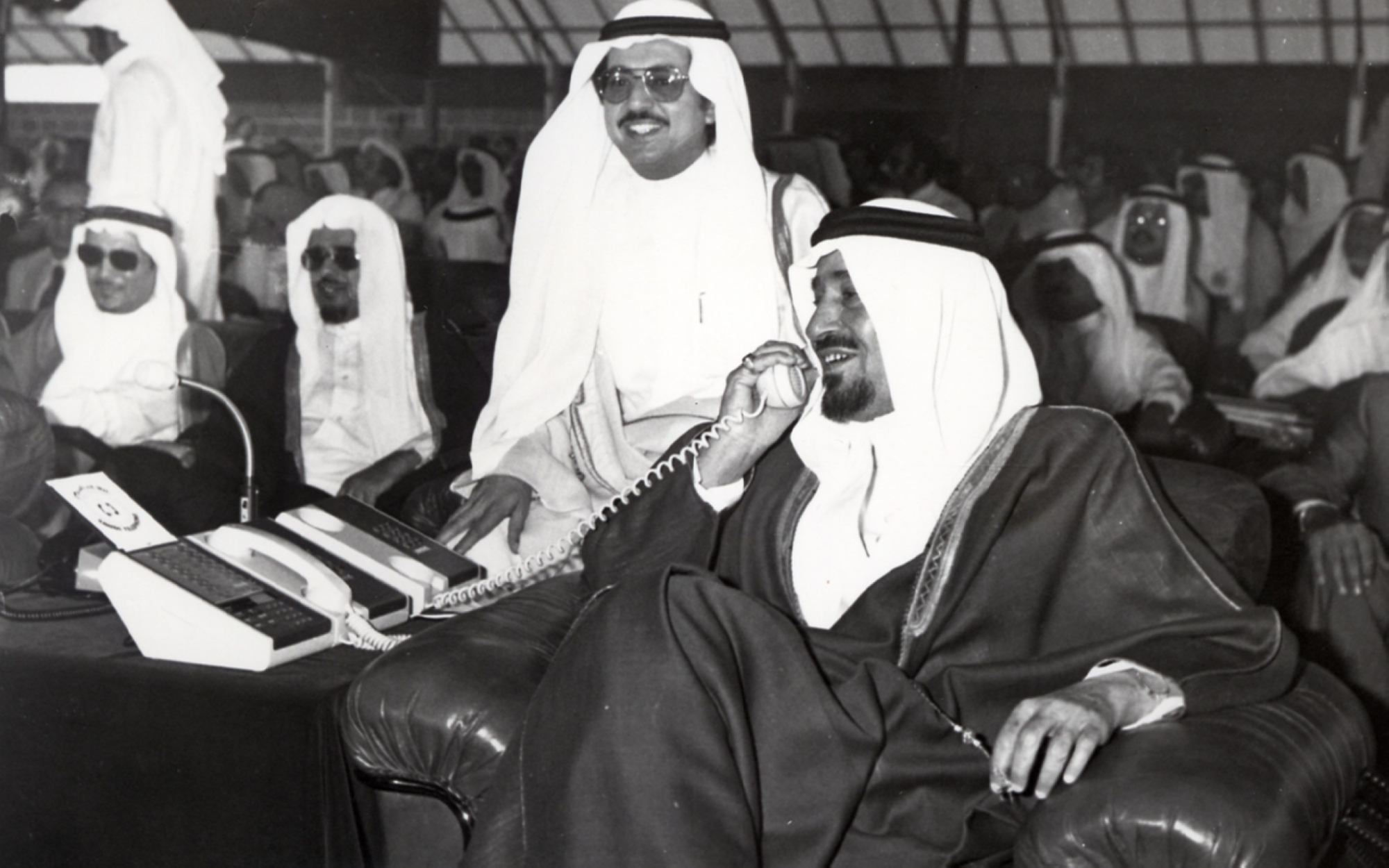
King Khalid assuming the rule of Saudi Arabia
Allegiance to King Khalid
On March 25, 1975, the day of the martyrdom of King Faisal, the royal family convened, headed by Prince Mohammed Bin Abdulaziz, the eldest son of King Abdulaziz at that time. They pledged allegiance to the Crown Prince, Prince Khalid Bin Abdulaziz, as the King of Saudi Arabia. King Khalid then announced the nomination of Prince Fahd as crown prince, and the entire family agreed to it. They pledged allegiance to him. Subsequently, princes, scholars, sheikhs, ministers, dignitaries, and citizens pledged allegiance to King Khalid as the King and Prince Fahd as the Crown Prince.
King Khalid's initial decisions
King Khalid affirmed that his policy was the same as those of his predecessor, King Faisal Bin Abdulaziz. On the administrative front, he issued a Royal Order on March 28, 1975, stating that all members of the Council of Ministers would continue in their positions. The following day, on March 29, 1975, King Khalid issued a decree and three Royal Orders. In these, he appointed Prince Fahd as crown prince and minister of interior as deputy prime minister, Prince Abdullah Bin Abdulaziz, the chief of the National Guard, as second deputy to the prime minister, and Prince Nayef Bin Abdulaziz as the minister of state for internal affairs. Prince Saud al-Faisal became the minister of state for foreign affairs and a member of the Council of Ministers.
On the humanitarian front, King Khalid issued a general amnesty for all political detainees, inviting those who had fled to return to the country. The first amnesty for political detainees was issued on April 6, 1975. The second Royal Amnesty came on May 30, 1975, pardoning all prisoners except those convicted of murder, robbery, rape, and drug offenses. This royal gesture was a benevolent initiative for the people of Saudi Arabia, offering them the hope of returning to righteousness and contributing to the service of religion and the nation.
King Khalid's domestic policy
After assuming the rule, King Khalid issued a statement outlining his governance approach for the country, specifying the foundations of his domestic and foreign policies. He began by expressing condolences for the death of King Faisal, emphasizing that Saudi Arabia's policies would continue to follow al-Faisal's principles both domestically and internationally. The statement underscored King Faisal's clear political plan and constructive approach to nation-building, ensuring the desired development for the people. The statement elucidated key pillars of Saudi Arabia's domestic policy through main axes: affirming that Islamic Sharia is the foundation of governance in all matters of Saudi Arabia, highlighting the state's commitment to improving the living standards for citizens and residents, advancing the second development plan, and enhancing human resources, industry, and agriculture. The statement also emphasized support for the armed forces in defense of Saudi Arabia, the Arab nation, and its causes. It reiterated commitment to development projects for citizen well-being and security, expressing a desire to support hospitals, provide necessary medical treatment, prevent diseases, and complete public service infrastructure, including transportation, roads, ports, airports, and wired and wireless communications. King Khalid expressed his wish for Saudis across Saudi Arabia to find housing with access to all necessary services.
King Khalid expressed his desire to strengthen state institutions, particularly in the Shura and governorate systems. His statement outlined that all these objectives aim to continue strengthening the administrative state institutions, developing their efficiency and effectiveness, and evolving their systems to serve. The statement also laid the foundations for Saudi Arabia's foreign policy on several axes: affirming Saudi Arabia's steadfast commitment to supporting global peace, following the policies of King Faisal, King Saud, and King Abdulaziz, supporting Islamic solidarity as the primary pillar of Saudi foreign policy, backing Arab unity, confirming Saudi Arabia's enduring stance on the Palestinian issue, and reiterating Saudi Arabia's commitment to the petroleum policy that has earned it a prestigious international status. The statement specified the role of Saudi Arabia concerning the world countries, extending its hand to Arab, Islamic, and friendly nations as long as they adhere to principles of truth, justice, and peace.
During the Grand Mosque seizure, which began at dawn on November 21, 1979, King Khalid Bin Abdulaziz demonstrated strong resolve in confronting the extremist group, successfully restoring control of the mosque. He also issued a Royal Order granting financial and material rewards to the families of the martyrs from the armed forces.
Continuing the development plans
King Khalid upheld King Faisal's developmental approach, building on the initiated progress. The implementation of the initial five-year plan, spanning from 1971 to 1975, was nearly complete, and the second five-year development plan, from 1976 to 1980, was underway and coincided with King Khalid's assumption of the rule. The total financial requirements for this plan amounted to SAR498.3 billion, marking an 8.9 percent increase from the initial five-year plan. The plan succeeded in achieving its objectives, with an average gross domestic product (GDP) growth rate of 8.4 percent. The non-oil sector experienced annual growth of 15.82 percent, and Saudi Arabia managed to control inflation rates, which did not exceed 6 percent at that time. The total allocation for the third five-year plan 1981-1985, which commenced during King Khalid's reign, amounted to SAR782.8 billion, witnessing an allocation increase of approximately SAR284.5 billion compared to the previous plan.
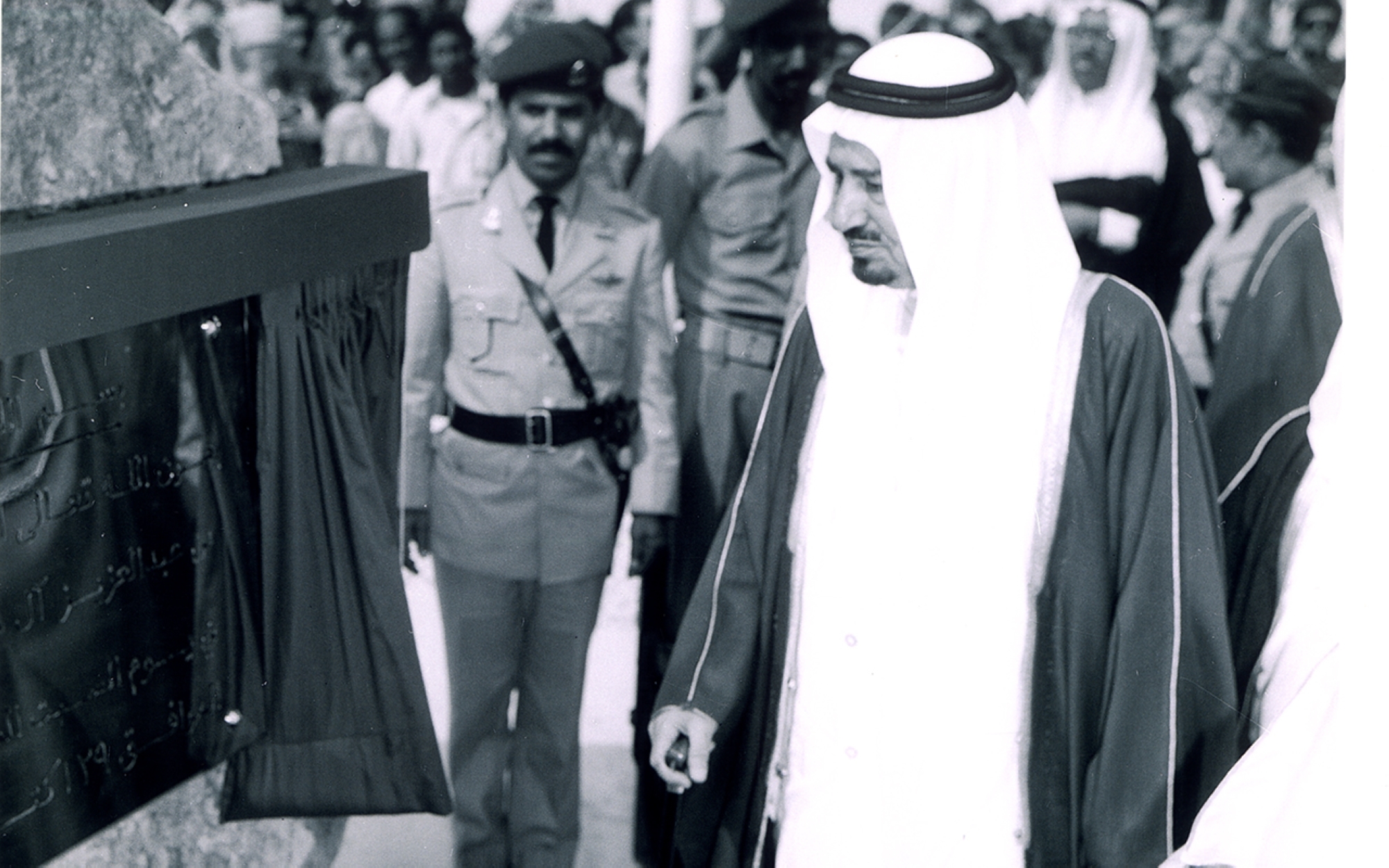
Major achievements during the reign of King Khalid Bin Abdulaziz
Educational advancement
During King Khalid's reign, the Ministry of Higher Education was established under the ministerial restructuring in 1975. King Faisal University in al-Ahsa was inaugurated in 1975, followed by Umm al-Qura University in Makkah al-Mukarramah in 1981. Since the establishment of the ministry, the number of students in higher education, both in universities and girls' colleges, increased. The number of students studying abroad also grew, and there was a doubled focus on scientific research in higher education. Saudi Arabia established the National Center for Science and Technology in 1977, which evolved in a subsequent phase and was named King Abdulaziz City for Science and Technology, aiming to build a scientific and technological foundation serving development in the fields of agriculture, industry, medicine, engineering, and astronomy. The Energy Research Institute and the Institute of Astronomy and Geophysics were established in 1980. The same year marked the beginning of forming scientific societies and organizations that played a role in supporting scientific and technological activities.
All educational institutions received significant attention. These included scientific institutes, adult literacy programs (for males and females), education for individuals with special needs, private education, and Quran memorization schools. In King Khalid's era, the first secondary school for Quran memorization for boys was inaugurated in 1976, and the first elementary school for Quran memorization for girls was opened in 1979. These schools operated parallel to the general education system, with a focus on courses related to the Quran and Hadith. The Ministry of Labor and Social Affairs (currently the Ministry of Human Resource and Social Development) oversaw the General Organization for Technical Education and Vocational Training (currently the Technical and Vocational Training Corporation), established in 1980. The vocational training centers that were under the Ministry of Labor and the Ministry of Education and Higher Education (currently the Ministry of Education) were merged into a single organization.
Development of health services
During the reign of King Khalid, the Ministry of Health achieved significant accomplishments, focused on providing healthcare services for everyone. In 1976, a ministerial council for health planning was established to develop the workforce operating in the health sector. The council included the membership of the Minister of Planning, the Minister of Health, and the Minister of Higher Education. This contributed to the increase in the number of health institutes under the Ministry of Health, reaching eighteen institutes for males and twenty-eight institutes for females by 1982.
The Ministry of Higher Education and the Ministry of Health contributed to training and building the medical workforce, through the establishment of medical colleges in Saudi universities. During the reign of King Khalid, the Faculty of Medicine and Applied Medical Sciences at King Abdulaziz University was inaugurated in Jeddah in 1975, along with the College of Medicine at King Faisal University in the Eastern Province in the same year. Additionally, the College of Medicine at King Saud University's Abha branch was opened in 1981. In addition to university hospitals, King Abdulaziz University Hospital, affiliated with King Abdulaziz University, was inaugurated in Jeddah in 1977, King Fahd University Hospital, affiliated with King Faisal University, was inaugurated in 1981, and King Khalid University Hospital, affiliated with King Saud University, was established in Riyadh in 1982.
One of the achievements of the Ministry of Health during King Khalid's reign was the establishment of the King Fahd Medical City in 1981, which is among the largest healthcare complexes. The ministry also focused on incorporating modern technology into the healthcare system, introducing the Medical Air Evacuation Project in 1980. The second development plan emphasized integrating preventive and therapeutic service programs with the support of primary healthcare centers, contributing to a decrease in the infant mortality rate.
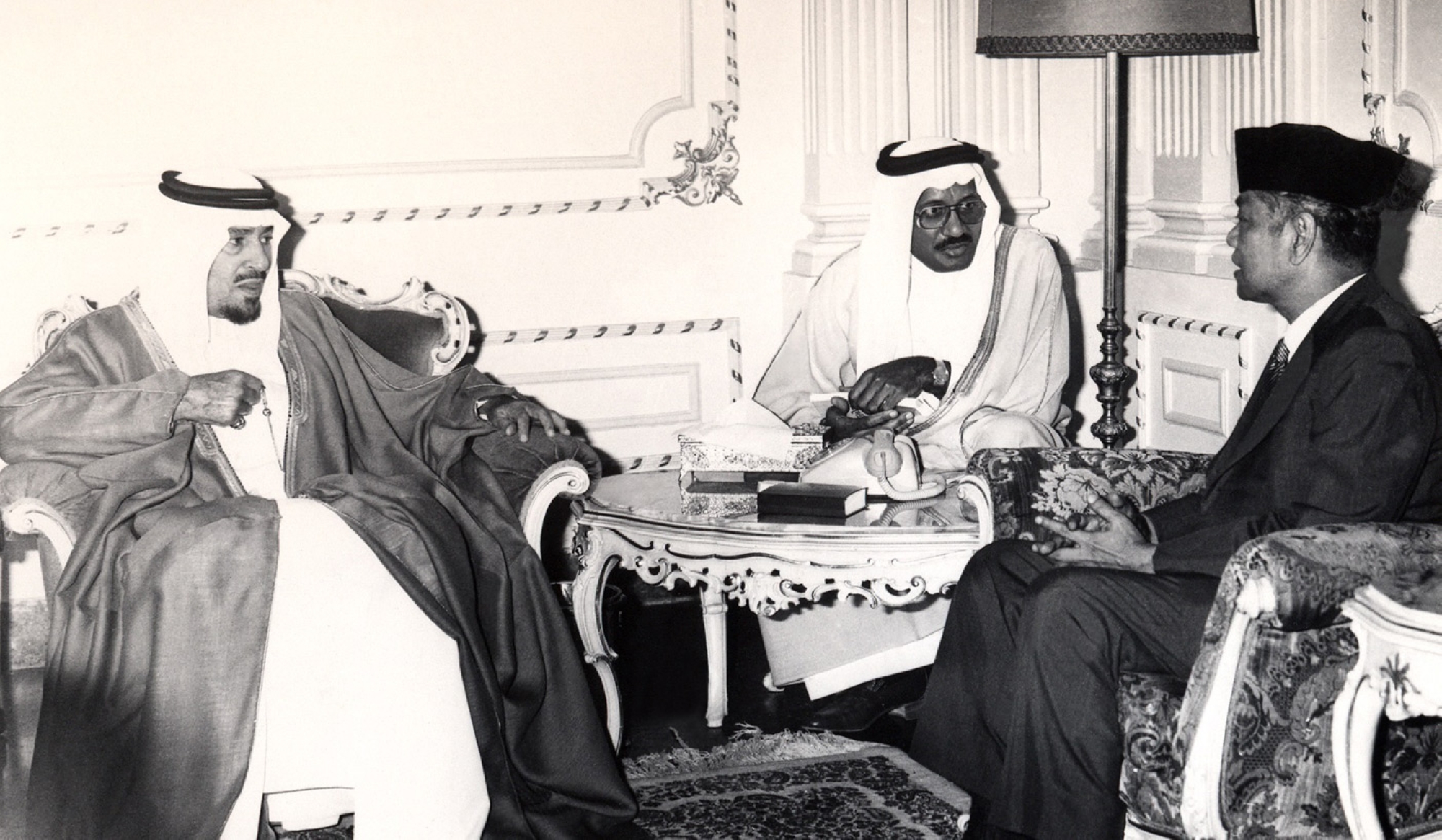
Military affairs and civil aviation
During King Khalid's reign, the Ministry of Defense and Aviation (now the Ministry of Defense) witnessed significant developments. In 1976, King Faisal Air Base in Riyadh was established as an extension of the progress made in building the air force, following the establishment of King Faisal Air Academy in 1967. To empower the Air Force, the Council of Ministers approved necessary arrangements for the F-15 aircraft deal with the United States in 1978. In 1981, a deal was concluded for the purchase of American AWACS aircraft. In 1976, the armed land forces command was established. King Abdulaziz Military College was developed to qualify its military personnel. In the Naval Forces, frigates were purchased, and units, such as marine infantry and security, were formed in 1980. The name of the Air Defense School changed to the Air Defense Institute in 1982 towards the end of King Khalid's reign.
In terms of military equipment development, stages began early in King Khalid's reign. Early during his reign, an agreement to establish the Arab Organization for Industrialization was signed between Saudi Arabia, Egypt, Qatar, and the UAE. A plan was set to develop and transform the basic Hawk missile equipment to an upgraded Hawk, which was implemented in 1980.
At the regulatory level, regulations were issued for the military sector. Amendments to the Officer Service Law and the Military Personnel Service Law were issued in 1977. The Military Retirement Law was also issued in 1975. The Military Service Council was established in 1982.
King Khalid Military College, affiliated with the National Guard Presidency (currently the Ministry of National Guard) was established on November 30, 1979. On the technical institute level, the Technical Studies Institute for the Naval Forces was inaugurated in the Eastern Province. From the beginning of 1979, the institute started conducting continuous courses for naval forces personnel.
The Air Defense Institute was established during King Khalid's reign, initially as a wing (department) in the Artillery School in Taif, known as the Anti-Aircraft Artillery Wing. In 1962, the first Air Defense School was founded in Jeddah as an extension of this wing. In 1982, the school's level was raised to meet the needs of air defense groups stationed across Saudi Arabia.
Regarding military supply and logistics, the Ministry of Defense developed, during the reign of King Khalid, a comprehensive strategy for the organization, armament, and nomenclature of military units and sectors, specifically between 1975 and 1980. The two schools were merged into the Supply and Logistics Authority. As for teaching vehicle driving, centers were established in regions for driving training as needed. During King Khalid's reign, the War Police School in Taif transformed into a wing within the Infantry Center and School in 1980. Later, the name was changed to the Special Military Police Center and School.
On the residential facilities front, the Saudi Armed Forces witnessed the laying of the foundation stone for King Khalid Military City. On Wednesday, February 1, 1978, King Khalid visited King Khalid Military City in the northern region, of Hafar al-Batin. The city was inaugurated during the reign of King Fahd Bin Abdulaziz in 1984. It was named the Northern Military Region. Additionally, on the eastern coast of Saudi Arabia, in 1981, King Abdulaziz Naval Base was constructed in Jubail, allocated for housing the employees of the Saudi Naval Forces in the region. King Khalid inaugurated the base on Monday, November 23, 1980.
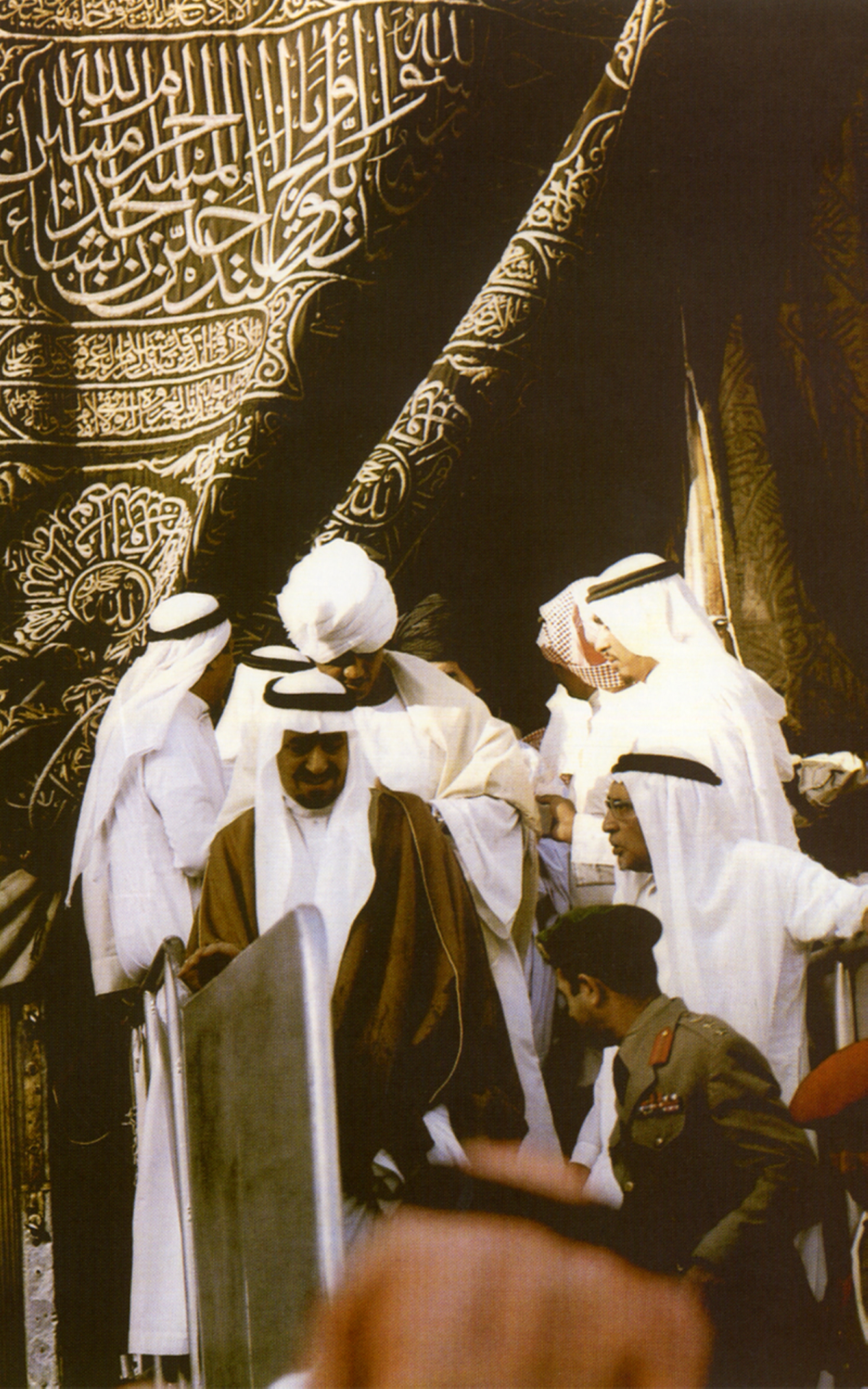
The Two Holy Mosques and the Holy Sites
During the reign of King Khalid, the Factory of Kaaba Kiswa (currently known as the King Abdulaziz Complex for Holy Kaaba Kiswa) was inaugurated in Umm al-Joud Neighborhood in Makkah al-Mukarramah in 1977. The Ministry of Hajj and Endowments (currently the Ministry of Hajj and Umrah) was entrusted with overseeing the construction and operation of the factory. The factory was equipped with modern machines for fabric preparation, while maintaining the manual production method due to its high value. In 1977, King Khalid ordered the crafting of a new door for al-Kaaba al-Musharrafa after performing prayers inside the Kaaba and observing the old door constructed in 1943 during the reign of his father, King Abdulaziz. He ordered the crafting of the new door from pure gold. He also ordered the crafting of Bab al-Tawbah (the Door of Repentance), the inner door of al-Kaaba, from Mekong wood covered with gold sheets. The work on the door took a whole year, starting on November 1, 1978. King Khalid ordered the manufacture of a new internal Kiswa for al-Kaaba al-Musharrafa to replace the old one.
King Khalid also ordered the installation of air conditioning units between Safa and Marwa and a path for the elderly and disabled individuals with wheelchairs. Additionally, construction, decoration, and lighting works were carried out on the seven minarets, each reaching a height of ninety-five m. The seven minarets are distributed at the following entrances: two minarets at the entrance of the door of the King, the same at the doors of Umrah and Salam, and the seventh minaret on the side of the Dome of Safa. The project was inaugurated on October 13, 1979.
In 1980, the General Presidency for the Affairs of the Grand Mosque and the Prophet's Mosque (now known as the General Authority for the Care of the Affairs of the Grand Mosque and the Prophet's Mosque) established the "Zamzam Watering Department" to oversee the Zamzam watering services. In 1978, the area of the Zamzam basement was expanded. During the reign of King Khalid, several administrations were formed in the Grand Mosque, including the Committee for the Promotion of Virtue and the Prevention of Vice in 1977, the Tawaf Administration in 1978, the Furnishings and Furniture Administration in 1978, the Doors of the Grand Mosque Administration in 1979, and the Courtyards Administration in 1979. The project to illuminate the Haram started at the beginning of King Khalid's reign. Electronic systems were introduced in the Grand Mosque in 1977, such as programmed electric clocks and electronic lesson recording. King Khalid directed a further expansion of the area in front of the King Abdulaziz Gate, Ali Gate, and Umrah Gate to improve the movement of cars and individuals in the surrounding areas and those leading to the Grand Mosque.
Regarding the Prophet's Mosque in al-Madinah al-Munawwarah, a fire broke out in the fabrics market southwest of the Prophet's Mosque on July 4, 1977. The fire lasted for three full days, causing extensive damage to the market. King Khalid ordered the acquisition of the land where the market was located, transforming it into a spacious courtyard within the Prophet's Mosque. Part of this courtyard was covered with canopies, which were added to the shaded area established during the reign of King Faisal. Another section was designated as a parking area and necessary services for the Prophet's Mosque. The total area of this acquired land was 43,000 m². The ground was paved with marble and equipped with electricity for lighting, fans to alleviate the heat, and sound amplification connected to the unified internal broadcasting network of the Prophet's Mosque. The design of the courtyard and all its services were planned to align with the previous expansion carried out during King Faisal's reign. Surrounding wide streets and squares were also designated as roads and parking areas to facilitate smooth movement around the Prophet’s Mosque.
Transportation sector
During King Khalid's era, administrative development included restructuring the Ministry of Transportation (currently the Ministry of Transport and Logistic Services). This structure comprised several departments, including the Design and Bridges Department, the General Execution Department, the Materials and Research Department, the Maintenance Department, and the Compensation Department. After the establishment of the Ministry of Posts, Telegraph, and Telephones, the ministry became responsible for roads, transportation, and ports. A Supreme Order issued on August 26, 1976, established the General Organization of Ports (currently the Saudi Ports Authority), making it an independent organization organizationally linked to the Council of Ministers' presidency. Consequently, the ministry focused on transportation and roads. In 1976, the Deputy Ministry of Transportation for Transport Affairs was established by a resolution from the Council of Ministers and tasked with coordinating the transport sector.
By the end of the third development plan in 1985, Saudi Arabia had an extensive network of paved roads, spanning 29,655 km, while agricultural roads extended to 50,655 km. On February 4, 1979, a Royal Decree was issued to establish the Saudi Public Transport Company. Since its inception, the company has played a significant role in providing low-cost means of transportation between key population centers and facilitating the transportation of Hajj and Umrah pilgrims from across Saudi Arabia to Makkah al-Mukarramah and al-Madinah al-Munawwarah.
In the field of rail transport, the Railroad Administration transformed into a general organization. On June 2, 1982, the Board of Directors issued a resolution to change the name of the organization to the Saudi Railways Organization (currently known as the Saudi Railways). Due to increased imports at the Riyadh port and the large volume of cargo, constituting 60 percent of the port's goods, there was a need to establish a dry port in Riyadh. The Minister of Finance and National Economy issued a decision on January 31, 1981, to establish a customs department at the dry port in Riyadh. This department handles customs procedures for all incoming goods. The Riyadh Dry Port facilitated the transportation movement of goods to Riyadh, facilitated customs clearance, and delivered them to importers in their warehouses. The port's area exceeded one million m2, and its construction cost was SAR269 million. It encompasses essential facilities for delivering, sorting, storing, and clearing goods, including expansive warehouses and a massive refrigeration unit spanning 2,700 m2, segmented into varying temperature zones, as needed. Administrative offices, offices for shipping companies, customs brokers, adjacent railway lines to warehouses, and equipment maintenance workshops are also incorporated. The Riyadh Dry Port was officially inaugurated on May 24, 1981, under the patronage of the Custodian of the Two Holy Mosques, King Salman Bin Abdulaziz, when he was the governor of Riyadh Province.
Regarding maritime transport, the General Ports Authority gained autonomy from the Ministry of Transportation on August 26, 1976. Since its establishment, it has been associated with several major ports, including King Abdulaziz Port in Dammam, Jubail Industrial Port, Jubail Commercial Port, Jeddah Islamic Port, Jazan Port, and Yanbu Port, along with a number of smaller ports and harbors along the Red Sea and Arabian Gulf coasts. Within six years of its establishment, the volume of unloaded goods had more than tripled, with the annual import value increasing to SAR100,000 million, constituting 50 percent of the total national spending in 1981. Simultaneously, exports surged more than tenfold. At its inception, the General Ports Organization had thirty-one berths, expanding to 114 berths by 1980.
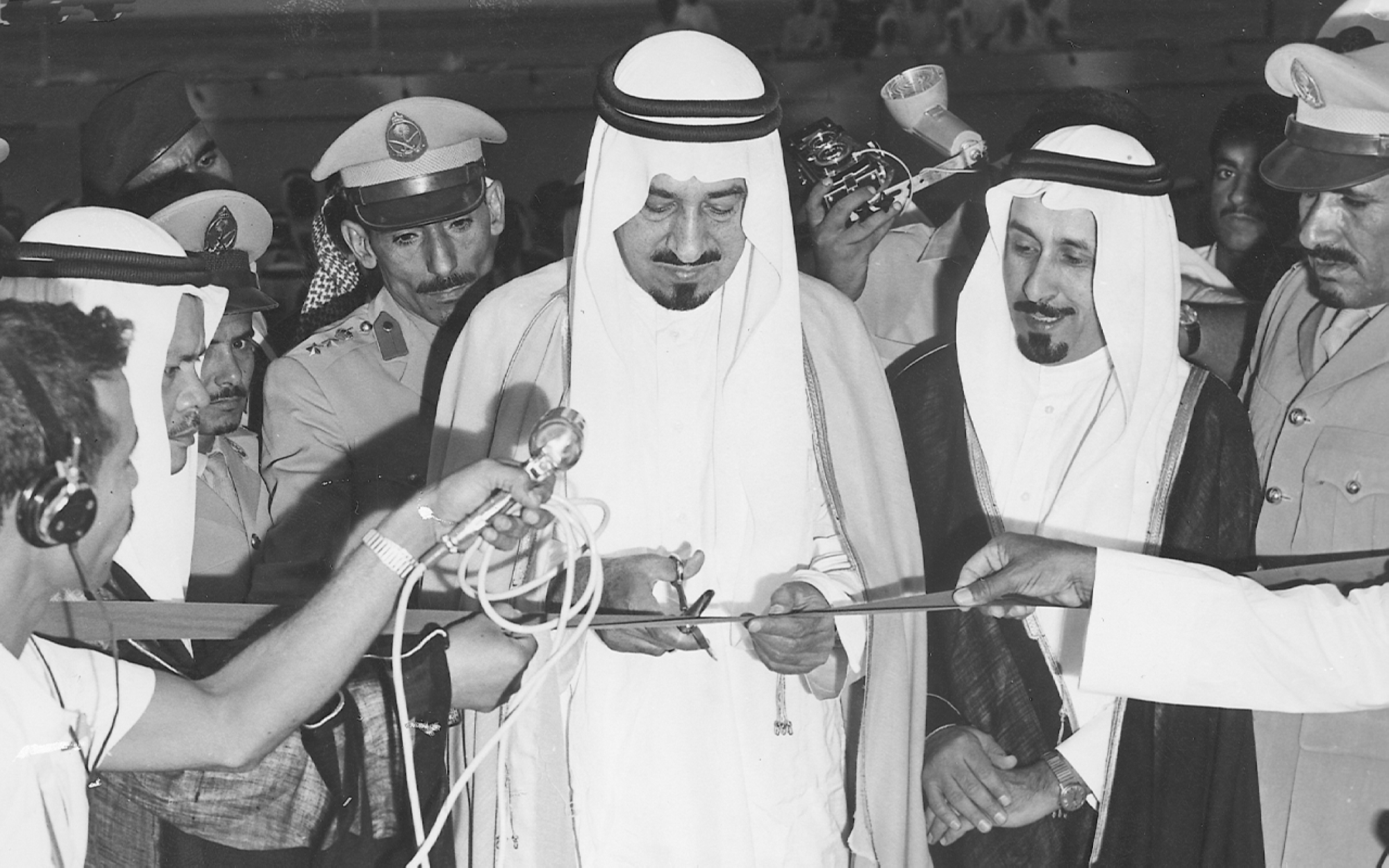
The development of the media sector
The Ministry of Media witnessed significant development during the reign of King Khalid, highlighted by the establishment of the Higher Council for Media in 1977, which contributed to advancing Saudi media. Additionally, the Deputy Ministry for External Media was established in 1979 to keep pace with developments both domestically and internationally. The four sectors of media, radio, television, publishing, writing, and journalism, experienced notable growth. By the year 1980, the number of main radio stations reached thirteen, covering 70 percent of the population, with an increase of three new stations since 1975. The number of FM radio stations reached nine, with an increase of six new stations, and the number of languages used expanded from eight to thirteen. The Ministry of Media emphasized employee training, establishing the Radio and Television Training Institute in 1976 in Riyadh City. The daily radio broadcasting hours increased to eighty-eight hours per day across all stations, covering regions across Saudi Arabia, the Arab Gulf countries, east and south Asia, north and central Africa, and some European countries. In 1979, the general fundamental rules for news in radio and television were issued, and the Saudi Press Agency was tasked with collecting official news and distributing it domestically and internationally, expanding its activities and increasing the number of its offices.
In 1975, Riyadh Television Complex was established, and color television broadcasting commenced for the first time in Riyadh in 1976. Modern communication technologies via satellites were employed in television broadcasting in 1977 when the ministry leased two satellite channels from the International Telecommunication Union. The number of television broadcasting centers reached forty-five by 1980, covering 60 percent of the population. There were six main television production centers, and Saudi Arabia participated in founding the GCC Joint Production Program Institution in 1976. The Gulf Television (Gulf Radio and Television for the GCC States) was established in 1977. Saudi Arabia supported the Arab League Education, Culture, and Science Organization (ALECSO). It also contributed to establishing the Arab Satellite Communications Organization, Arabsat, in collaboration with the Arab League and the International Telecommunication Union in 1976.
During King Khalid's era, the Ministry of Media attached great importance to written media. The number of private media institutions in the printing field increased from 197 in 1976 to 537 in 1983. The Law of Printed Materials and Publication was issued in 1982. Several private institutions were established, contributing to the development and growth of Saudi journalism in all aspects. Additionally, many government agencies published weekly and monthly magazines, along with numerous specialized academic journals from Saudi universities. Most chambers of commerce and industry published magazines specializing in industry, finance, and business.

King Khalid Bin Abdulaziz on the international stage
International visits to strengthen Saudi relations
During King Khalid's reign, a ministerial resolution was issued on June 8, 1980, to make changes in the organizational structure of the Ministry of Foreign Affairs. The ministry was divided into five departments: Political Affairs, Economic Affairs, Administrative Affairs, Consular Affairs, and Ceremonial Affairs. Branches were also established in Jeddah and Dammam. As Saudi Arabia's relations developed under King Khalid, the number of Saudi embassies and consulates in other countries increased, as well as the number of embassies and consulates of other countries in Saudi Arabia. Additionally, Saudi Arabia became the headquarters for numerous regional and international organizations. The number of new embassies for Saudi Arabia in other countries reached twelve, and the number of new embassies for other countries in Saudi Arabia reached seventeen.
To strengthen Saudi relations, King Khalid visited several Arab and allied countries, including nineteen countries. They are:
He visited the United Arab Emirates on March 27, 1976, and had a second visit on May 25, 1981. During the latter visit, he led the Saudi delegation to the first meetings of the Gulf Cooperation Council.
Kingdom of Bahrain on March 23, 1976.
State of Qatar on March 25, 1976.
Sultanate of Oman on March 29, 1976.
State of Kuwait on March 21, 1976, and a second visit on January 1, 1978, to offer condolences on the death of Sheikh Sabah Bin Salem al-Sabah.
The Hashemite Kingdom of Jordan on December 23, 1975.
Republic of Sudan on October 30, 1976.
Syrian Arab Republic on December 25, 1975.
Libyan Arab Jamahiriya on September 29, 1979.
The Arab Republic of Egypt, with the first visit on July 16, 1975, the second visit at the invitation of President Mohammed Anwar al-Sadat on March 29, 1976, and the third visit on October 24, 1976, to attend the Eighth Arab Summit Conference on October 25-26, 1976.
Kingdom of Morocco on May 19, 1979.
Iran on May 24, 1976.
Pakistan on October 10, 1976.
Spain on June 15, 1981.
Federal Republic of Germany on June 15, 1980.
Belgium, at the invitation of King Baudouin I of Belgium, on May 8, 1978.
France on May 29, 1978.
Britain, at the invitation of Queen Elizabeth II, on June 9, 1981.
United States of America on October 27, 1978.
King Khalid position on Arab, Islamic, and global issues
Saudi Arabia's foreign policy during King Khalid's era was built on firm foundations and principles, grounded in Islamic Sharia, international conventions, and diplomatic norms. It employed balanced methods and approaches to achieve its objectives, relying on composure, self-discipline, transparency, and independence. This approach garnered respect and appreciation on the Arab, Islamic, and international levels. King Khalid played an active role in the Arab, Islamic, and international scenes in solidifying Saudi Arabia's foreign relations, documenting Saudi Arabia's ties with countries worldwide, and reinforcing alliances based on security preservation and mutual interests. Apart from visiting Arab, Islamic, and foreign nations, he received a number of kings and presidents from over fifty-seven countries from across the world in Saudi Arabia. He discussed with them issues raised in the Islamic and international arenas, common relations between their countries and Saudi Arabia, and concluded several political, economic, and developmental agreements. King Khalid sought to persuade presidents to stand by the Palestinian cause and support Islamic issues, and organized the Third Islamic Conference in Makkah al-Mukarramah in 1982. He also supported Islamic labor organizations. During his reign, the Gulf Cooperation Council (GCC) was established in 1981, with Saudi Arabia being one of its key founding pillars.
The death of King Khalid Bin Abdulaziz
Announcement of the death of King Khalid
King Khalid passed away in Taif City in Saudi Arabia, on June 13, 1982, at the age of seventy-one. His funeral prayer was held in Riyadh, and he was laid to rest in al-Oud Cemetery. During his seven years of rule, he dedicated himself to the development and construction of Saudi Arabia in various fields of development. He adhered to the standards of civilizational progress, while preserving the constants of the Saudi state and its Islamic principles. Under his reign, Saudi Arabia gained prominence in Arab and Islamic policies. King Fahd Bin Abdulaziz succeeded him in ruling the country.
King Khalid's family and children
King Khalid married at an early age and became a father before the age of twenty. He was blessed with several sons, including Princes Bandar, Abdullah, Fahd, and Faisal, and six daughters: Princes Moudi, al-Jawhara, Nouf, Hussa, Mashael, and al-Bandari.
Awards and honors for King Khalid Bin Abdulaziz
King Khalid was awarded the King Faisal Prize for Service to Islam in 1981, and he was selected as Man of the Year in 1976. He received the Gold Medal for Peace at the Third Islamic Summit Conference held in Saudi Arabia in 1981. Additionally, he received a number of honors, including:
The Grand Sash of Zaire, on the occasion of the visit of the President of Zaire to Saudi Arabia in 1974.
The Order of High Civil Merit, on the occasion of the visit of the Crown Prince of Spain to Saudi Arabia in 1974.
The Order of the African Star and the Grand Sash, during the visit of the Liberian President to Saudi Arabia in 1974.
Order of al-Hussein Bin Ali, on the occasion of the royal visit to Jordan in 1975.
The Order of the Nation and the Grand Sash, on the occasion of the royal visit to Syria in 1975.
The Grand Sash of the Republic of Niger, during the visit of the Nigerian President to Saudi Arabia in 1976.
The Order of Mubarak the Great, on the occasion of the royal visit to Kuwait in 1976.
The Collar of Independence, on the occasion of the royal visit to Qatar in 1976.
The Grand Al Nahyan Order, on the occasion of the royal visit to Abu Dhabi in 1976.
The Order of the Renaissance of Oman, during the royal visit to Oman in 1976.
The Medal and Order of Pahlavi, on the occasion of the royal visit to Iran in 1976.
The Grand Order of the Nile, during the royal visit to Egypt in 1975.
The two-piece Nishan-e-Pakistan, on the occasion of the royal visit to Pakistan in 1976.
The Grand Cross of the Order of Honor, on the occasion of the visit of the French President to Saudi Arabia in 1977.
The Grand Sash, on the occasion of the visit of the Mauritanian President to Saudi Arabia in 1976.
The Order of Brilliant Star, on the occasion of the visit of the Chinese President to Saudi Arabia in 1977.
The Grand Sash of Honor for the Great Liberator Simon Bolivar, on the occasion of the visit of the Venezuelan President to Saudi Arabia in 1977.
The Grand Order of Isabella the Catholic, on the occasion of the visit of the King of Spain to Saudi Arabia in 1977.
The Grand Mono Order with the Grand Cross, on the occasion of the visit of the King of Togo to Saudi Arabia in 1977.
The Shash Order of the Leopard, on the occasion of the visit of the Zairian President to Saudi Arabia in 1978.
The Sash of the Order of Bath, on the occasion of the visit of the Queen of Britain to Saudi Arabia in 1979.
The National Order of Merit, from Guinea, in appreciation of the efforts of the King and his role in the Islamic and global arena.
The Order of the Crescent of Anjouan, on the occasion of the visit of the President of the Comoros to Saudi Arabia in 1979.
The Grand Cordon al-Mohammedi, on the occasion of the royal visit to Morocco in 1979.
The Grand Order of Mugunghwa, on the occasion of the visit of the Korean President to Saudi Arabia in 1980.
The Grand Cross Shash of special class, on the occasion of the royal visit to Germany in 1980.
Entities bearing the name of King Khalid Bin Abdulaziz
Several facilities and sectors carry the name of King Khalid in appreciation of his achievements, including: King Khalid International Airport in Riyadh, King Khalid Military City in Hafar al-Batin, King Khalid Military College, King Khalid University in Abha, and King Khalid University Hospital, King Khalid Eye Specialist Hospital and Research Center, King Khalid Cultural Center in Buraidah City, and King Khalid Wildlife Research Center. Additionally, following his reign, the King Khalid Foundation was established to enhance social, educational, cultural, and professional standards in Saudi Arabia.
Related quizzes
Related articles

